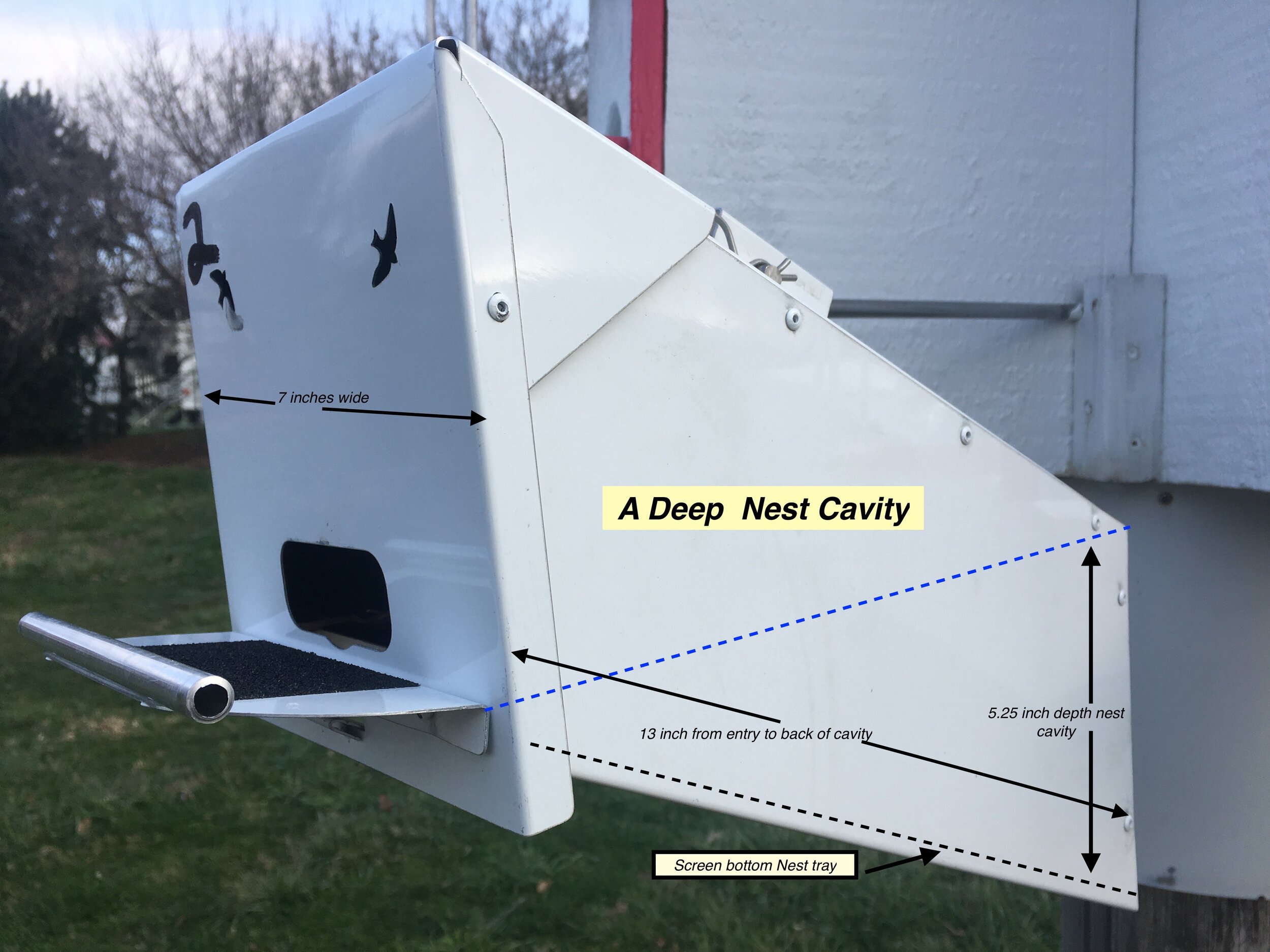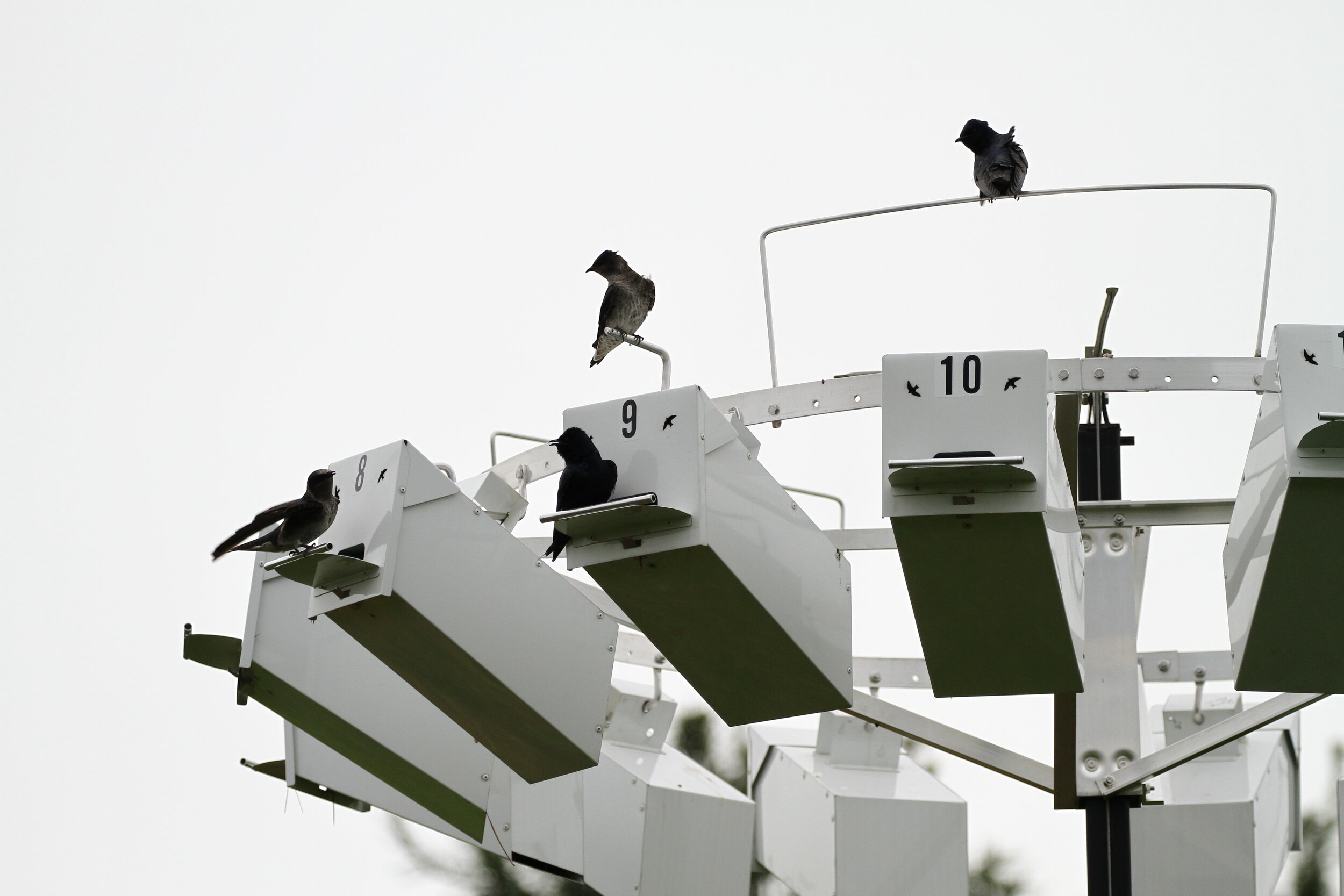Features include:
Deep safe cavity for nest and eggs. Bottom of the nest cavity is almost five inches below the entrance. Now with modified excluder SREH openings.
A DEEP NEST CAVITY
With a nesting surface well below the entrance, the occupants feel secure, tucked in and less likely to try and flee upon an owl attack. With the added weight of nest material and developing young, the nest cavity depth below the bottom of the entrance may increase to over six inches due to the intended change of balance of the box.
Each ChirpyNest box is constructed from high quality aluminum and weighs approximately 39 ounces including the removable nest tray, comparable to most plastic gourds.
With a distance of 12.75 inches from entry to back of the nest tray, the birds are safer from the long reach of great horned owls and less likely to try and flee when under attack.
Martins during Summer 2018 at VHCC in Abingdon VA
Slant box creates a "nest pocket"
The use of a sloped nesting surface evolved from a modification I made to my T-14 house in 2004. It was then that I closed off the second from top compartment on each side and dropped the back of the top floor to rest on the second compartment floor, creating a deep compartment with a sloped floor that created a secure 'pocket' for the nest. The T-14 became a T-10. These modified top compartments became the first claimed each year since.This, I think is more in tune with the natural woodpecker holes Martins historically used and the birds have an added sense of security. I designed my ChirpyNest housing with this in mind and the martins love them.
fresh leaves added to a pre-nest with freshly laid eggs in the screen bottom nest tray. hatching occurs 15 days after the last egg is laid.
NEVER A WET NEST / SCREEN NESTING SURFACE.
I’ve had Martin nests in every other type of housing, get soaked on rainy and humid days. Drainage openings in gourds clog when the nest is built. Flat bottomed houses allow water to seep beneath the walls and that moisture is absorbed into the nest material. Once moisture gets into bedding, a nest has a very hard time drying out. From there, conditions in the nest can quickly deteriorate. Even weather tight housing can have issues with wet nests as water drains off wet parents and normal respiration of occupants can build up as condensation.
By incorporating the screen bottom tray, the nest surface sits above the cavity bottom and since the cavity bottom is sloped, any free moisture entering the cavity will drain to the back of the cavity and flow out of the compartment. The superior ventilation of the cavity prevents build up of condensation creating a very dry environment. With ChirpyNest, the stench from a wet nest is a thing of the past!
Nest tray slides out for nest checks and nest change outs. I usually check nests every five - 7 days and change the nest material when nestlings are 10-12 days old.
REMOVABLE NEST TRAY
Removable nest trays are an integral part of the ChirpyNest. Nest checks are fast and more accurate, as you can easily look for the eggs under nest material. Nest change outs take no time as the replacement nest can be made prior to inspection. End of season clean out is fast and easy, just dump the contents and move on to the nest house.
Front access makes nest checks easy and fast. The new locking tab improves on the original hooks used to lock the front panel.
FRONT ACCESS TO COMPARTMENTS
Front access allows for easier, faster and more accurate nest checks and nest changes. Wing entrapment guards are now included with the modified excluder entrances. Traction strip on the porch allows the martins to enter easily through the starling resistance openings.
Martins like individual cavities. ChirpyNest has the convenience features of multi compartment Purple Martin housing with much better conditions than gourds.
INDIVIDUAL UNIT HOUSING
Martins really like individual units. Gourds have been the most used type of individual housing. The ChirpyNest single units expand on this by providing better access for nest checks and management. After building the four compartment ChirpyNest houses, I realized that the single units may be a better way to continue my quest for the Martin housing of the 21st century.
After switching gourds to ChirpyNest houses my fledge rate has increased and jumpers are a rarity.
with SREH's a major threat to martins is controlled.
STARLING RESISTANT OPENINGS (SREH)with wing entrapment guards
No martin housing should be sold today without Starling Resistant Entry Holes. While not 100% starling proof, SREH’s are the single most important advancement in purple Martin management in my lifetime. To have housing without SREH’s is inviting unnecessary stress to a colony. Now includes the modified excluder entrance. For 2023, the porch has been modified as a one piece porch/perch as seen in images on the “become a ChirpyNest landlord” page.
Natural flow through ventilation keeps compartment cool and dry.
INCREASED VENTILATION / COOLER CAVITY
The ChirpyNest system increases ventilation within the cavity. As air warms in the cavity, it rises and exits through the entrance and the two ventilation holes in the front panel. Outside air enters through the opening in the cavity bottom creating a natural air flow throughout the Martin nest cavity.
Temperature studies conducted during the past 2017 and 2018 and 2019 nesting season show the maximum daily temperature inside the ChirpyNest averaged 4.47 degrees below that of an unvented supergourd, and 2.08 degrees below the maximum daily temperature of a vented super gourd. ChirpyNest averaged almost 1 degree cooler that the air temperature. Cooler cavities keep help prevent pre-mature fledging.
This has translated to an 88.9% fledge rate for eggs that hatched vs a 74.5 % rate for plastic gourds at my colony sites over the last three years.
Carry four in each hand with a simple stick.
Stackable storage saves space and aggravation.
EASY UP IN SPRING / EASY CLEAN UP IN FALL
The ChirpyNest is designed to hang on the 3/8 inch hanging arms of a typical gourd racks. The ChirpyNest can be ordered for use with either vertical arms or horizontal arms. With that in mind it is easy to give martins a wide choice of housing on a single rack in order to evaluate the housing most suitable for the landlord. A ChirpyNest hung on horizontal arm will rock side to side. Hung on a vertical arm it will rock front to back. a ‘rocker stopper’ is included with the vertical mount if a fixed mount is desired.
At seasons end, To clean just dump the contents of the nest tray, brush the bottom and hose out if desired. The single units can be stacked for storage.
Any water that might enter the cavity including condensation and shedding from the martins themselves, will quickly drain and evaporate.
Opening allows for flow through ventilation and drainage keeping cavity cool and dry.
With the screen bottom nest tray the nest stays dry. If rain blows into the cavity front, it never reaches the nest. I don’t use a canopy above the front entry as I think it reduces visibility for the martins as they exit. making them more prone to attack.
CAVITY WIDE OPENING AT BACK OF COMPARTMENT FOR VENTILATION, DRAINAGE AND PEST MANAGEMENT
This cavity wide opening provides drainage from the cavity and provides ventilation for the cavity. The combination of a screened bottom, a sloped cavity bottom and cavity wide opening at the back bottom of the cavity is the basis of the ChirpyNest Hygienic Nesting System. The system allows nest debris, parasites s/a blowfly larvae and water to fall through the screen bottom tray and exit the cavity by gravitational forces out the back opening of the cavity.
In the first two seasons of use I have found that blowfly larvae will develop between the moist layers of leaves brought in during incubation. Many of these larvae will fall through the screen but the leaf layer provides security for these parasites and they don’t have to burrow to the bottom of the nest. However after the first nest change this leafy habitat is eliminated and infestations have been stopped. I attribute this reduction in blowfly larvae to a drier nest and less conducive habitat for development. With out the leafy layers the larvae burrow to the nest bottom where they fall through the screen and lose access to their host. In other housing the larvae develop under the nest and return to the the birds to feed. One nest change is all it takes to control the blowfly with the ChirpyNest.
I have been able to eliminate the need for a second nest change out with the ChirpyNest system.
During nest checks the cavity below the nest tray is full of nest dander and debris which is easily pushed out the back of the cavity.
Using the ChirpyNest system I have increased my colony to its largest size ever. in 2021 my fledge rate was 95%. 358 of 375 young successfully fledged.
Landlords across the country are discovering ChirpyNest, spending more time enjoying their martins and less time worrying about wet nests, jumpers and owl predation.
Add ChirpyNest to your Purple Martin colony to experience the advanced features of the
ChirpyNest Hygienic Nesting Cavity.
No further Modifications needed.
Each ChirpyNest Has starling resistant entry holes with wing entrapment guard and includes removable nest tray.
The universal hanging bracket can positioned for vertical or horizontal hanging arms depending on your setup.
All ChirpyNest houses are hand built in Abingdon VA.
ChirpyNest can be used on any gourd rack using 3/8 inch hanging arms.
You can also hangChirpyNest using wires like a traditional gourd
Join the Colony of ChirpyNest Purple Martin Landlords group on Facebook












